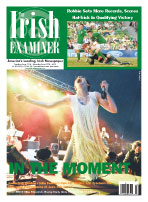


SERVICES
Tuesday April 3, 2012
Getting Ready For Tartan Week
By Gwen Orel Just when St. Patrick's day is over, and the March season begins to draw to a close, the Scottish season begins. Scotland week, or Tartan week, culminates in the Tartan Day Parade on April 14, with Grand Marshall Brian Cox. All kinds of Scottish events will be going on, including Whiskey Live! Single malt tastings on April 11 (americanscottishfoundation.com/tartanDay/whiskylive.html), Scottish plays at 59E59 (www.59e59.org), an evening with the Scottish band Scocha at St. Andrew's Restaurant on April 12, and much more. One of the most exciting events kicking off the celebrations, is an exhibit from the The Leabhar Mor/ Great Book of Gaelic (leabharmor.net])at Ellis Island Immigration Museum (tartandayonellisisland.com) through April 8. This remarkable anthology has been touring the world since its debut in 2002 - what we have here is not the book itself but some of its artwork, with readings and performances on April 3 and April 5 (details below). The book consists of 100 Gaelic poems chosen by 50 of the most noted poets in Ireland and Scotland, with artistic responses by 100 artists, and beautiful calligraphy as well. The poems represent work from the 6th century to the present, and the exhibition traces the Celts from their origins in Central Europe through the Greater Gaidhealtachd of Scotland and Ireland right through to the migrations to the Americas. Ellis Island, of course, is the spot where so many immigrants came through before they reached their new home. The exhibition is progressed by the Gaelic Arts Agency, Proiseact Nan Ealan (PNE), in partnership with the Clan Currie Society. One thing the book demonstrates, says Malcolm McLean, Director of the Gaelic Arts Agency, is that the ties between the Scots and the Irish run very deep. "The truth is," he told us by phone from his home in Lewis, "Gaelic is the same language regardless of where it's spoken in Ireland or Scotland. There are only 650 words of a difference bet Irish Gaelic and Scottish Gaelic." The grammar is the same, and in fact, he explained, "Historians and archaeologists can find no meaningful differences between Scottish Gaelic culture and Irish Gaelic culture until the 16th century. "The northwest of Scotland, the highlands and islands, had much more in common with Ireland than the rest of Britain, or even Scotland. "There was the same language, music, the same bardic traditions, same social structures." The golden age of Gaelic actually survived a couple of centuries beyond its peak in Ireland. The differences that we perceive are not so much differences as deliberate political, historical and religious schisms, brought about by (well, we know who) an attempt to divide and rule. "Essentially it was the one culture, the greater Gaeltacht, of Ireland and Scotland, for best part of 1000 years. It did not suit the strategic or political or religious interests of the time for such a strong Gaelic alliance to be allowed to continue." The book is partly a result of the revival in Scottish Gaelic that began in the 1980s, and, MacLean said, "has led to major breakthroughs on behalf of the Gaelic language in Scotland in past 10 years, including a Gaelic language television channel, and an act of parliament. "We started building bridges with gaelic Ireland in the '80s and '90s, and the book emerged from that." But even if you've no interest at all in the social and historical meaning of the language, the book is a treasure. As MacLean explained, it's an unconventional anthology because the poets picked their favorite poems, not the ones that are most important or most well known. It offers an "interesting insight into the poet's own taste," he said. Take this one, 'Te De Cholinn Iccoinnich,' which begins, in English, I like Ailean Dubh from Lochy," then goes on:
In Gaelic:
The poem is by "anon MacKenzie Woman," c. 1700, and was chosen by Meg Bateman. The calligrapher Ann Bowen has written it with scratchy black letters with red in the background-suggesting blood and violence but also, somehow, dreams. And the artist responding is Sean Hillen - two hands in modern sleeves grasp each other, against a background of houses on hills, and a red sky. MacLean told me that it's Bosnia. The poem is haunting, hard to grasp, hard to forget. The letters and the picture capture its mystery. It belongs to all Celts. And to the world. LEABHAR MOR READINGS IN THE POETS HOUSE, MANHATTAN The events take place in The Poets House at 10 River Terrace (corner of Murray) in Manhattan, looking out to Ellis and immediately adjacent to the Irish Famine Memorial. On Tuesday 3rd and Thursday 5th April three eminent Gaelic poets will read a selection of poems from the Great Book and some of their own work. The readings will be bi-lingual - in the original Gaelic with English translations - and refreshments will be available on both evenings. The three poets are: Aonghas Dubh MacNeacail
The Tuesday 3rd April event begins at 7.15pm with a 30 minute screening of Murray Grigor's BBC film, "Is Mise An Teanga/I Am The Tongue", about the making of the Great Book and the Scots/Irish Gaelic connection. This will be followed by Q&A. The readings will begin at 8pm. The Thursday 5th April event begins at 7.15pm with a rare opportunity to hear the leading expert on the subject, Dr Michael Newton, talk about "Gaelic Voices in Exile: The History and Literature of the Gaels in America". This will be followed by Q&A and readings will begin at 8.15pm. |
CURRENT ISSUE

RECENT ISSUES


SYNDICATE
[What is this?]
POWERED BY

HOSTED BY

Terms of Service | Privacy Policy
Website Design By C3I






